Menu
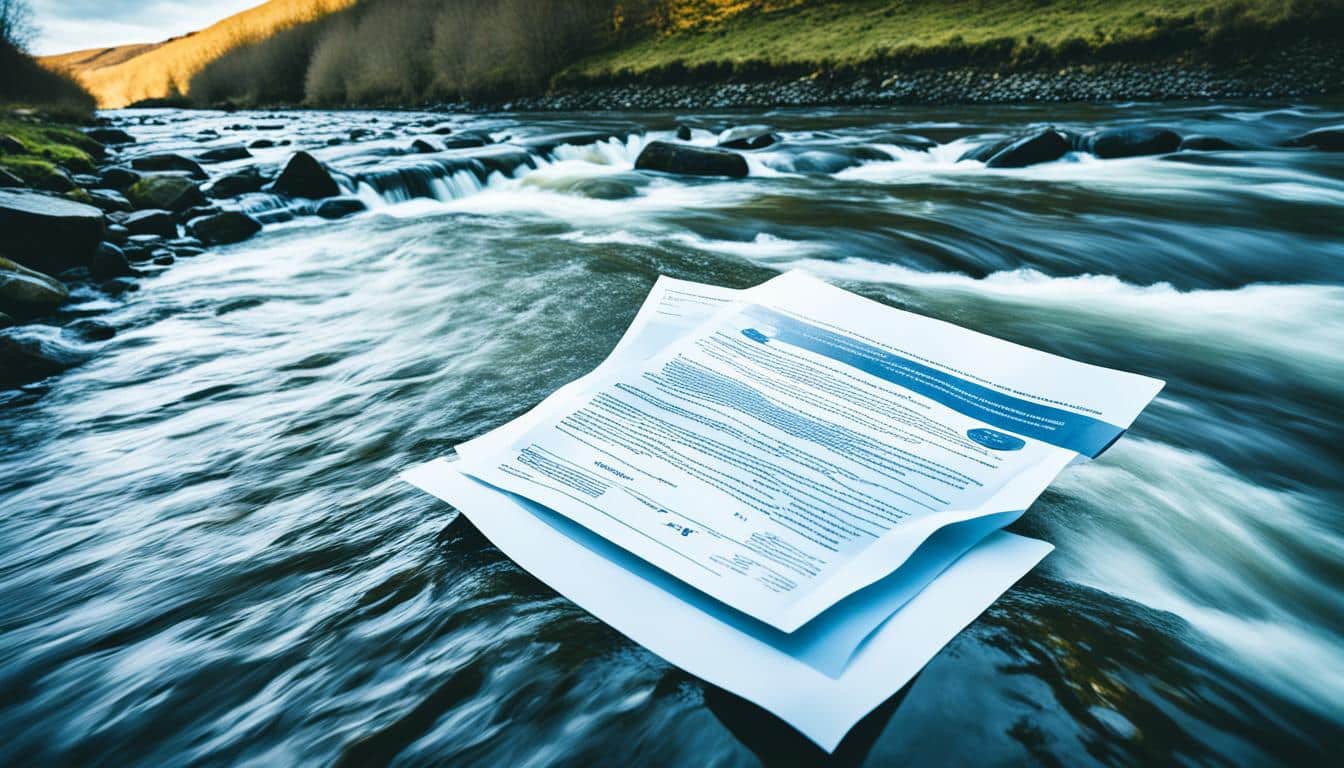
In England and Wales, doing unapproved water discharge activities can lead to big fines or jail time. The law shows how important managing water is in the UK.
The UK Water Resources Act from 1991 is a key law. It covers water usage, quality, and keeping water clean from pollution. This law brings together many rules in one place.
It talks about managing water, keeping it clean, and flood defence. The Environment Agency looks after this law. They make sure people follow it to protect the environment.
The Water Resources Act 1991 was a big step forward in UK water legislation. It became law in December 1991, merging over 20 different water laws into one. This made the approach to water management across the UK more consistent and effective.
One major part of the Water Resources Act 1991 is the General Quality Assessments (GQAs). These tests check the health of rivers and lakes by looking at the plants and chemicals in the water. Water companies have to plan how they’ll look after water over 25 years. This is all part of keeping our water systems healthy for the future.
Section 85 of the Act is important too. It makes hurting the water on purpose or by accident a serious crime. People who break this law could go to prison for up to 2 years, get fined up to £20,000, or both.
There’s also a part about areas where the water is at risk, called nitrate vulnerable zones. These areas grew from 55% to 68% of the land by 2009. The Act also introduced guides for farmers, known as the Codes of Good Agricultural Practice. These guides help farmers use the land in ways that don’t pollute the water.
The story of water laws in England and Wales goes back to 1963. The Water Resources Act 1963 started it all, setting up groups to look after rivers and making plans for using water. It helped make sure that water management was done well and efficiently.
Building on the 1963 law, the Water Resources Act 1991 added more good ways to manage water. It created rules for taking and storing water, making sure that nature isn’t harmed. This Act made our system for looking after water even better, aiming for a healthy water future.
The UK’s journey with water laws started way before the Water Resources Act 1991. It was made up of many separate laws that covered different parts. This made it hard to work together and understand.
Back before 1991, UK water laws began with the Water Resources Act 1963. This act set up river authorities and a Water Resources Board. The laws progressed, showing that views on managing water needed more clarity.
The 1963 Act was detailed, showing laws around water were complex. 27 River Authorities took over from the 32 River Boards. Laws for specific areas, like the River Thames, were also part of the mix.
The UK Water Resources Act 1991 was needed to bring all the separate laws together. Before 1991, there was more than 20 different laws about water. This was too many, so they made a new, single law. This change was part of making water laws clearer and easier to enforce, overseen by the Environment Agency.
| Year | Legislation | Key Provisions |
|---|---|---|
| 1948 | River Boards Act | Initial setup of River Boards |
| 1963 | Water Resources Act | Formation of River Authorities and Water Resources Board |
| 1991 | Water Resources Act | Consolidation of over 20 water laws |
Combining all the water laws made them clearer and more logical. It aimed to make managing water better by setting up a more efficient system. This included improving water quality and acting stronger against pollution.
The Water Resources Act 1991 is a key law in the UK. It helps manage water, protect the environment, and control water quality and pollution. Its main goals are to use water sustainably, stop water pollution, and set up a good system for water management.
The main aim is to keep water clean by closely watching and controlling it. The Act lists goals and standards for water quality. Tools like General Quality Assessments check water quality to keep the environment safe.
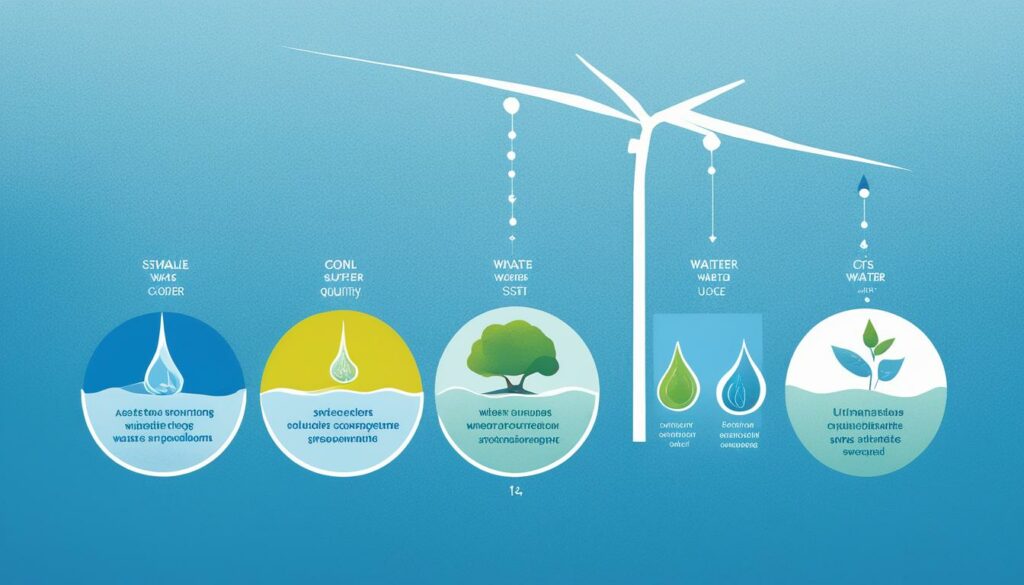
It also focuses on managing water carefully. It gathers past laws on water management under Part II. This part sets up a strict system for using water, making sure its effect on the environment is minimal.
Preventing water pollution is another important goal. The Act has a section, 85, that tackles water pollution offences. It says anyone causing pollution can face big fines or jail, even without meaning to.
It’s also about planning for the future. The Act needs water management plans. These plans help reach its aims for using water well and managing resources right. The authorities have to show they’re taking action against those who break the rules, which proves they’re serious about sticking to the Act.
All in all, the objectives of UK water legislation are fully achieved through this strong law. The Water Resources Act ensures the UK handles its water wisely and keeps the environment safe.
The Water Resources Act 1991, Part II, outlines the roles and duties of the Environment Agency in looking after water across the UK. It looks to balance sustainable practices with the needs of water companies.
The Environment Agency is tasked with overseeing the fair use of water. They check water quality through General Quality Assessments (GQAs) which look at both biological and chemical aspects. By doing this, they make sure water meets the standards. If not, they act fast to stop long-term harm to the environment.
A key part of their work is to control who can take water and how much. Most takes of water need a license, except for small amounts up to 20 cubic metres a day, if certain rules are followed. The Water Abstraction Plan (2017) and Abstraction Licensing Strategies make the process clear and fair for everyone.
Recently, the law has been updated by the Environment Act 2021. Now, in some cases, no compensation for changing or losing your water license is needed. It shows the UK’s dedication to looking after water well and introduces tighter rules for better environmental protection.
Water companies in the UK must make 25-year plans according to these laws. These plans show how they will manage and keep water safe for the long term. By following the rulings of the Environment Agency, water companies work towards helping the environment and ensuring water for the future.
The Act also lays out punishments for rule-breaking. This aims to deter and penalize any actions that harm the water. Penalties range from fines to being put in jail. These strong laws make sure looking after the water is always a top concern.
| Measure | Detail |
|---|---|
| Evaluation Systems | General Quality Assessments (GQAs) |
| Abstraction Licence Requirement | Most abstractions/impoundments require a licence |
| Exemption for Small Quantities | Up to 20 cubic metres in a 24-hour period |
| Strategic Plans by Water Companies | 25-year Water Resources Management Plans |
| Penalties for Contraventions | Fines up to £20,000 or imprisonment |
Maintaining high water quality is key under the Water Resources Act 1991. It creates a strong system to protect controlled waters. This is done through setting and checking standards carefully.
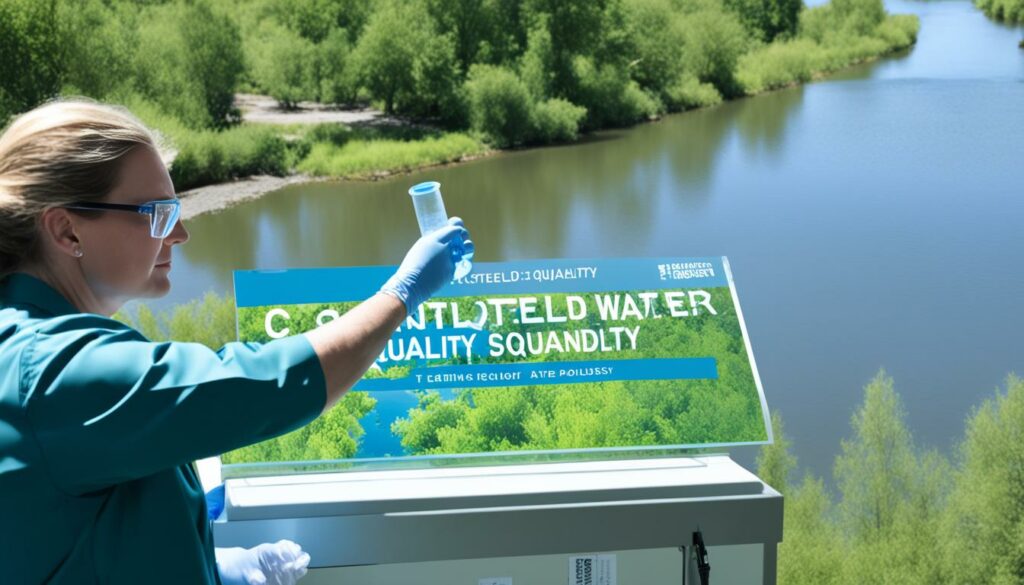
The Act clearly states what level of quality controlled waters must meet. It groups them by use and what’s in them. Sections 82 to 84 are crucial for these rules, keeping our water healthy. By outlining controlled water quality standards, the Act makes sure we watch over our waters.
To make sure the standards are met, the Environment Agency does General Quality Assessments. These checks look at the effect of substances on our waters. GQAs help us understand their ecological health. But, not acting on low GQA results is a problem. This shows we need better rules here.
| Regulation Aspect | Objective | Mechanism |
|---|---|---|
| Controlled Water Quality Standards | Maintain Health of Waters | Classification and Regulation |
| General Quality Assessments (GQAs) | Monitor Inland Waters | Biological and Chemical Testing |
| Enforcement Mechanisms | Ensure Compliance | Penalties and Sanctions |
The UK water quality assessments and Environment Agency monitoring are critical. They aim at preventing water pollution actively. But, we need to improve how we act on GQA results. This is essential to make water quality management stronger in the UK.
The Water Resources Act 1991 outlines measures for water pollution control. It aims to protect the environment with strict rules. One important rule is needing a permit to release sewage or effluent into UK waters.
Section 85 in this Act deals with serious polluters. It marks pollution offences as very bad, with tough punishments. People can get up to 3 months in jail, or a £20,000 fine. For worse cases, it might mean up to 2 years in jail or facing an unlimited fine.
These strict actions show how serious the UK is about environment protection.
Companies must get discharge consents from the Environment Agency to let out effluents. This rule is fundamental in the UK. The consent decides what can be released, making sure it doesn’t harm water quality.
These steps are key for keeping the environment safe and protecting water life. Discharge consents are vital for the Act’s aim to protect the environment.
To keep UK groundwater clean, certain areas follow strict rules. These rules help stop both dangerous and safe pollutants from getting into the water.
Nitrate sensitive areas stop nitrate pollution from farms. This pollution can come from fertilisers. To keep nitrates in check, experts look at the soil, drift, and rock. They then know where pollution is more likely. These areas help farmers do their job safely while keeping the water clean.
Water protection zones have rules to avoid bad things in the water. We can’t let in things like pesticides, oils, and heavy metals.
The rules also tackle two types of pollution. One comes from everywhere. The other is from one spot, like a spill or leak.
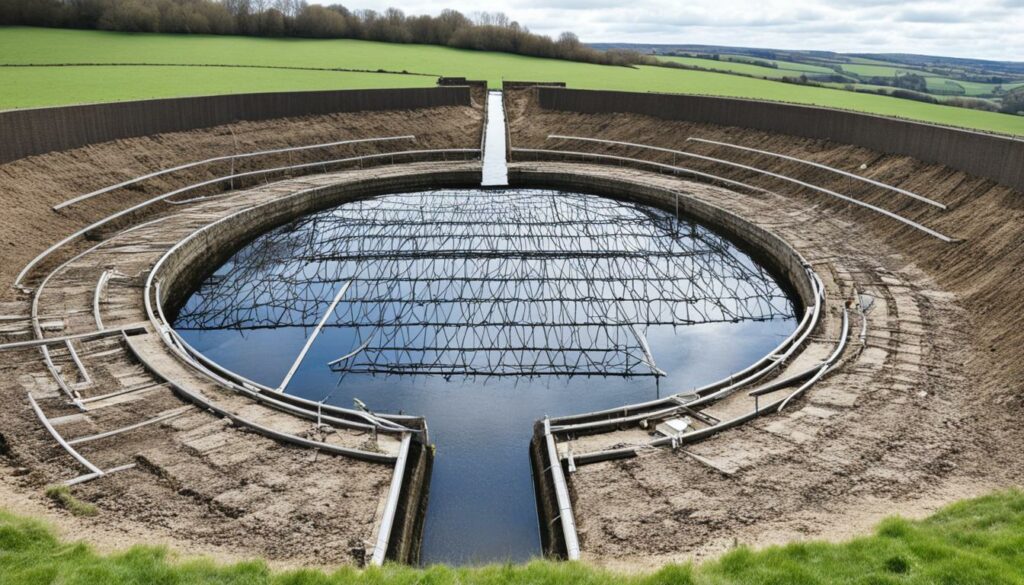
| Category | Details |
|---|---|
| Abstraction License | Required for abstracting more than 20 cubic meters of water per day |
| Aquifer Types | Principal, Secondary, Secondary Undifferentiated, Unproductive Strata |
| Pollutants | Non-hazardous (e.g., nitrates), Hazardous (e.g., pesticides, oils) |
| Pollution Types | Diffuse (widespread), Point Source (specific) |
| Regulatory Bodies | Environment Agency (England and Wales), SEPA (Scotland) |
The Flood and Water Management Act 2010 shows the UK’s need for strong flood defence. It’s a key part of the water Resources Act to reduce flood risks. The strategy aims to involve the public and manage risks across the country.
In July 2020, a new flood defence plan was put in place in the UK. This plan had a big impact on how we deal with floods. By September 2020, it was made mandatory for authorities to follow this new plan. This move gives the Environment Agency more power to make sure flood defences work well.
The Environment Agency plays a vital role in managing flood risks. It issued a Flood and Coastal Erosion Risk Management Strategy Roadmap to guide actions up to 2026. This plan also looks ahead to 2100. Now, flood risk actions are more carefully controlled under the Environmental Permitting Regulations.
Focusing on areas near rivers and flood plains, getting the right permits is very important. Not following rules from Section 107(3) WRA and off-limits areas can be a crime. This can lead to serious actions like warnings, cautions, or even court trials. The same goes if someone ignores a stop notice from the Flood Water Management Act. Touching the Environment Agency’s equipment is against the law too, further showing how seriously we take flood defence.
The table below gives an in-depth look at key rules and what happens if they are not followed:
| Compliance Aspect | Regulation | Consequences of Non-compliance |
|---|---|---|
| Activities near rivers and flood plains | Environmental Permitting Regulations | Requires a permit; non-compliance may lead to prosecution |
| Section 107(3) WRA notices | Flood Water Management Act | Warnings, formal cautions, and prosecution |
| Interference with Environment Agency apparatus | Section 176 WRA | Warnings, formal cautions, and prosecution |
The Environment Agency’s strong approach to flood defence under the water Resources Act is key. It helps protect our land and homes from floods. The UK’s proactive management of flood risks is setting a great example for others to follow.
The UK Water Resources Act is very important. It helps protect fisheries, which are key in the water world. This act supports using water in ways that help everyone, from fish to people. It makes sure that places where fish live are well-cared-for. This is vital for keeping our environment healthy and diverse.

Fish passes and screens are crucial under this Act. They make it easier for fish to move around, which is great for their natural life cycles. Without barriers, fish can find new places to live and maintain genetic variation. This way, fish populations stay strong and mixed, which is good for everyone.
Protecting water life is at the heart of the UK Water Resources Act. It does this by stopping the harmful taking of water and controlling pollution. These actions help keep the living conditions in the water space good for many different species. If someone does pollute, they face consequences. There are also plans to look after water and its life, making sure everything is used wisely and works together well.
The UK Water Resources Act has strict rules to make sure people and businesses follow water laws. If someone doesn’t follow these rules, they could face big fines or even go to prison. This shows how serious it is to obey water laws.
Breaking water laws by taking water without permission or not following a license brings either criminal or civil charges. Breaking the law might get you a warning or a fine. For civil cases, you might have to fix what you’ve done wrong or pay a fine.
In addition, starting December 11, 2023, there’s no limit to the fines that can be given out. These fines must match the size of the wrongdoing company. They can be for things like illegal waste dumping or rule breaking by companies, like those in manufacturing.
Water company bosses are also watched closely. Their pay can depend on how well they look after the environment. In 2022-23, no CEO got extra pay from money paid by customers. This shows that the rules for the bosses of water companies are getting stricter.
In the past, cases like Alphacell v Woodward have shown that companies can be heavily fined for pollution. Cases like this show that making mistakes with water can lead to serious trouble, highlighting the “polluter pays” idea. This helps keep water laws strong, making sure everyone takes them seriously.
The UK Secretary of State for Environment is key in managing the Water Resources Act 1991 (WRA). They have major tasks like making sure water is well managed in the UK. The WRA combines many laws into a clear set of rules to follow.

One important job is to set goals for water quality and judge how clean water is. This is done to protect the environment. They use regular checks to see if the water is clean for plants and animals.
The Secretary of State can make polluters face criminal charges. These can lead to a three-month jail term, a fine up to £20,000, or both. These tough rules show how serious the UK is about protecting water and the environment.
There are also other ways to punish polluters. This includes naming them, making them pay money, or following strict rules. These methods hope to stop bad practices before they harm the environment.
The Act lets the Secretary of State pick water protection zones and manage places sensitive to nitrates. With more areas being at risk from nitrates, this is very important. The goal is to not let nitrate levels in water go over what the EC says is safe.
To sum up, the Secretary of State’s job in managing water laws is very important. They make sure water is safe and used well. This keeps UK water healthy for the future.
The UK Water Resources Act focuses on using water wisely. It gives rules for planning how we use water, which stresses the need to save water. This law’s design supports saving water for everyone and for nature, using methods that are kind to the environment.
The Act stresses using water wisely. For example, it changed the rules for 23,000 water use permits, making 48% of them not needed anymore. But, experts warned that 10,000 new permits might have to be given for some activities. This change aims to help use water more carefully, fitting new needs without hurting the environment.
This law makes water companies in England and parts of Wales create and share water plans. These plans must look 25 years ahead, from 2010 to 2035. Planning for water needs in the long term helps keep our water safe and protect nature.
| Region | Long-term Plans |
|---|---|
| England | Water Resource Management Plans, CaBA partnerships |
| Wales | Water Resource Management Plans via Welsh Water |
| Northern Ireland | Sustainable Water 2015-2040, Living with Water Programme |
| Scotland | River Basin Management Plan 2021-2027 |
The mining sector is notably affected by these changes. The need to adapt water use rules affects how they can get water. The Environment Agency works on managing rivers, highlighting the importance of careful water use based on local needs.
Overall, the Act aims to make sure we use water in ways that save it. This requires regularly checking and updating how we manage water to keep it lasting long.
The Water Resources Act 1991 has seen many changes over the years. These updates help keep up with the ever-changing needs of water use and protecting the environment. The Environment Act 1995 and the Water Act 2003 brought big changes to the UK Water Resources Act. They updated the laws to face new challenges. For instance, Section 27 of the Water Act 2003 stopped people from getting compensation in certain cases. Section 58 of the Water Act 2014 did the same for water companies in some situations.
Changes were made to how water is taken out, too. The Water Abstraction Plan (2017) and the Environment Act 2021 made these updates in line with modern needs. For example, on January 1, 2018, old rules for water use were removed. This affected many industries and farming. Now, everyone has to manage water more carefully. This is all part of updating the laws to make sure water use meets today’s rules.
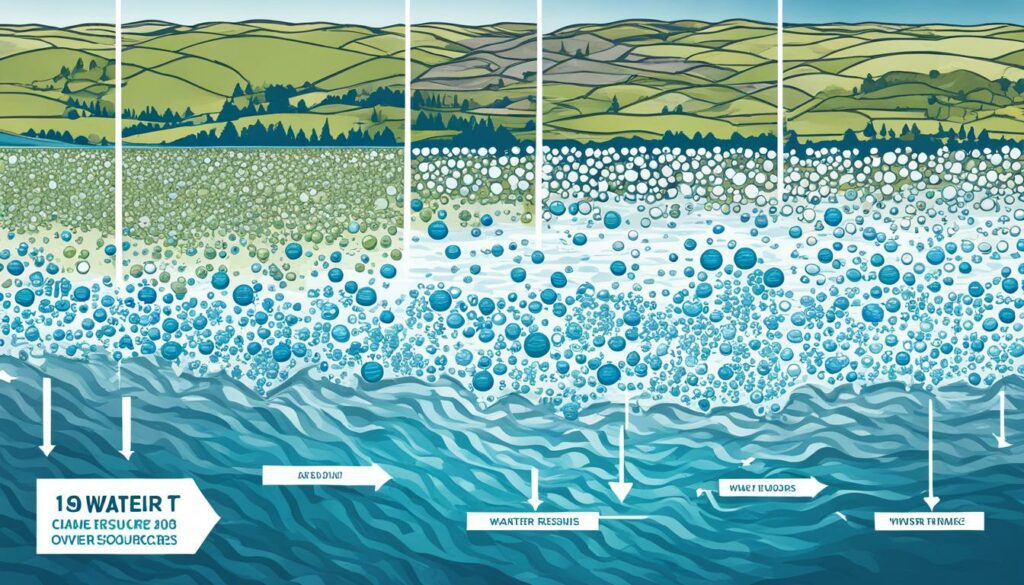
Dealing with drought has also seen big improvements. Drought orders and permits were added to the Water Resources Act 1991. These let the Environment Agency control water use better when it’s scarce. Also, the agency can put temporary limits on water use. These updates help manage water better when the weather is dry, and people need more water.
To sum up, the UK Water Resources Act has changed a lot. These changes are important in making water laws fit for today. They’ve helped in key areas, improving how water is used and protected.
| Legislation | Key Changes | Impact |
|---|---|---|
| Water Act 2003 | Withdraws compensation for certain license variations | Encourages sustainable resource use |
| Water Act 2014 | Revokes compensation for water companies | Rebalances economic incentives |
| Environment Act 2021 | Changes to abstraction licensing | Improved water management plans |
| Water Abstraction Plan (2017) | Reforms abstraction management | Promotes ecological sustainability |
| Removal of historic exemptions (2018) | Ends longstanding abstraction exemptions | Ensures comprehensive regulation |
The UK Water Resources Act has set tough rules for both industries and farms. Its goal is to reduce water pollution. It also aims to keep our water clean. These rules push for using water wisely.
Under the Act, industries face strict rules, especially about what they put into the water. If they need a lot of water, they must get a special permit. This is to make sure they don’t harm the water supply. They also use cool tech to keep an eye on their impact.
Since 1945, we’ve been working to manage how industries treat water. Back then, lots of different groups looked after water and waste. The Act helped bring everyone together. Now, it’s much easier to make sure they follow the rules.
In 2016, farming used about 14% of the UK’s water. But, it can cause problems like too many nutrients in the water. The UK launched the Farming Rules for Water to teach farmers how to protect water.
By 2017, farms were doing better at not putting too much nitrogen and phosphorus in the water. But, there are still worries. People are not sure how to set the right prices for water. Plus, we don’t have clear goals for how much water farms should use.
| Measure | Details |
|---|---|
| Reduction in Nitrogen Balance | From 107 to 86 kg/ha (2000-2017) |
| Reduction in Phosphorus Balance | From 10 kg/ha to 6 kg/ha (2000-2017) |
| Legislative Measures | Farming Rules for Water (2018) |
| Water Abstractions Percentage | 14% in total (2016) |
The UK has made big changes in how farms use water. They’ve helped many areas be less risky for water pollution. They offer lots of help and advice to farmers. This way, we can keep the water clean.
Enforcing the UK Water Resources Act faces big hurdles. One key problem is finding those who pollute. Figuring out where pollution started is hard, especially with so many sources. This is a big issue with pollution from farms. It’s hard to tell who’s to blame, making enforcement tough. Also, it’s not always clear if pollution was on purpose or not. This makes the legal side more complex.
Getting the right balance between progress and nature is tough, too. The Act says we must be careful with how we use water to protect the Earth. But, we also need to meet the water needs of a growing country and economy. By 2050, we might need 4 billion liters more water each day. This shows why managing water well is so urgent.
It’s key to push for saving water. Companies must cut down how much water they lose and use less water per person by 2050. They’re also asked to use smart meters and use less water at work by 2037/38. But, making sure these rules are followed takes a lot of work.
Getting to zero carbon emissions by 2030 adds more challenges. Looking at nature’s help and being ready for change are good steps forward. Local planning groups now look at more than just providing water to homes. They think about water for all, which is a smarter way to manage water.
Tackling these difficulties is crucial for the UK’s water future. It will help keep the environment safe while we keep growing. For deeper insight, check out the Environment Agency’s blog.
The UK Water Resources Act was passed in 1991. It covers water resources, quality, and pollution, plus flood defences. It combined over 20 laws into one, looked after by the Environment Agency.
The UK had many water laws before 1991. These laws often overlapped and confused things. So, the Act made things simpler by putting all water rules under the Environment Agency.
This Act has several goals. It wants to make sure we use water well, keep it clean, and manage it wisely. It also aims to stop water getting dirty and to have clear rules for keeping an eye on water in the UK.
The Environment Agency looks after water use carefully. It lets people take water but makes sure this doesn’t harm the environment.
It checks water quality and stops those who mix harmful things into water.
Taking water from nature needs a special permit now. The Environment Agency makes sure we use water fairly, without hurting the ecosystem.
Section 85 is clear about pollution in water. It says no one should harm water knowingly. And the Environment Agency can punish those who do.
The Act makes special places where care is needed in using land. It follows EU rules, keeping water clean from farm waste.
The Act helps the Environment Agency stop floods and keep us safe. It tells the Agency to think ahead, protecting homes and land from too much water.
The Act helps fish move safely. It wants to keep water animals healthy and the water safe. This way, we look after our rivers and seas better.
Not following the rules can lead to big fines or even prison. The idea is to scare away bad behaviour, making sure those who harm water are stopped.
The Secretary of State has a big job in looking after water. They set clear rules to keep water safe and make sure our water ways are looked after well.
The Act says we should not waste water and have good plans for using water properly. It tells us to keep our waters, lakes, and rivers clean.
Over time, the Act has been updated to tackle new problems. Changes were made by the Environment Act 1995 and the Water Act 2003.
The Act watches over how factories and farms use water. It pushes for ways to keep the water they use and return clean. This protects our water.
It’s hard to spot and punish those who harm water. Also challenging is making sure people follow the rules while still letting the country grow. Keeping these parts of the Act working is important.